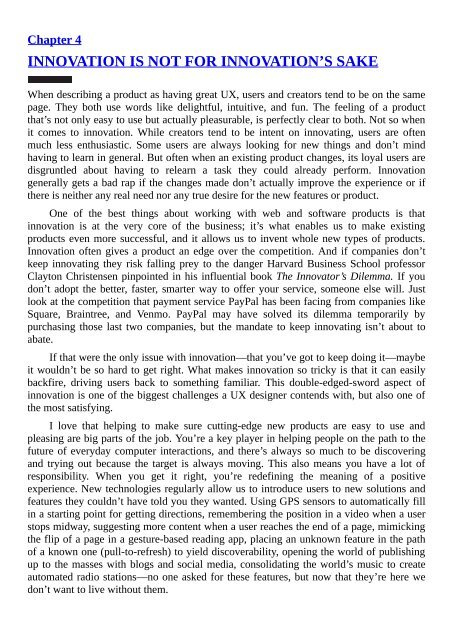Create successful ePaper yourself
Turn your PDF publications into a flip-book with our unique Google optimized e-Paper software.
Chapter 4<br />
INNOVATION IS NOT FOR INNOVATION’S SAKE<br />
When describing a product as having great UX, users and creators tend to be on the same<br />
page. They both use words like delightful, intuitive, and fun. The feeling of a product<br />
that’s not only easy to use but actually pleasurable, is perfectly clear to both. Not so when<br />
it comes to innovation. While creators tend to be intent on innovating, users are often<br />
much less enthusiastic. Some users are always looking for new things and don’t mind<br />
having to learn in general. But often when an existing product changes, its loyal users are<br />
disgruntled about having to relearn a task they could already perform. Innovation<br />
generally gets a bad rap if the changes made don’t actually improve the experience or if<br />
there is neither any real need nor any true desire for the new features or product.<br />
One of the best things about working with web and software products is that<br />
innovation is at the very core of the business; it’s what enables us to make existing<br />
products even more successful, and it allows us to invent whole new types of products.<br />
Innovation often gives a product an edge over the competition. And if companies don’t<br />
keep innovating they risk falling prey to the danger Harvard Business School professor<br />
Clayton Christensen pinpointed in his influential book The Innovator’s Dilemma. If you<br />
don’t adopt the better, faster, smarter way to offer your service, someone else will. Just<br />
look at the competition that payment service PayPal has been facing from companies like<br />
Square, Braintree, and Venmo. PayPal may have solved its dilemma temporarily by<br />
purchasing those last two companies, but the mandate to keep innovating isn’t about to<br />
abate.<br />
If that were the only issue with innovation—that you’ve got to keep doing it—maybe<br />
it wouldn’t be so hard to get right. What makes innovation so tricky is that it can easily<br />
backfire, driving users back to something familiar. This double-edged-sword aspect of<br />
innovation is one of the biggest challenges a UX designer contends with, but also one of<br />
the most satisfying.<br />
I love that helping to make sure cutting-edge new products are easy to use and<br />
pleasing are big parts of the job. You’re a key player in helping people on the path to the<br />
future of everyday computer interactions, and there’s always so much to be discovering<br />
and trying out because the target is always moving. This also means you have a lot of<br />
responsibility. When you get it right, you’re redefining the meaning of a positive<br />
experience. New technologies regularly allow us to introduce users to new solutions and<br />
features they couldn’t have told you they wanted. Using GPS sensors to automatically fill<br />
in a starting point for getting directions, remembering the position in a video when a user<br />
stops midway, suggesting more content when a user reaches the end of a page, mimicking<br />
the flip of a page in a gesture-based reading app, placing an unknown feature in the path<br />
of a known one (pull-to-refresh) to yield discoverability, opening the world of publishing<br />
up to the masses with blogs and social media, consolidating the world’s music to create<br />
automated radio stations—no one asked for these features, but now that they’re here we<br />
don’t want to live without them.


